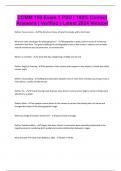Exam (elaborations)
COMM 150 Exam 1 PSU 100% Correct Answers Verified Latest 2024 Version
- Course
- Institution
Define: mis-en-scene - The directors choice of what to include within the frame What are some challenges for photographers? - Photography is static, both in terms of it freezing movement and time. The great challenge for photographers was to find a way to capture and recreate natural movement an...
[Show more]



